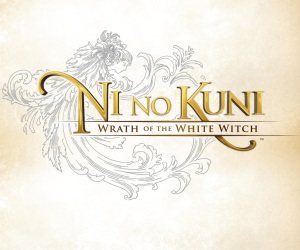 Game: Ni No Kuni: Wrath of the White Witch
Game: Ni No Kuni: Wrath of the White Witch
Developer: Level 5 & Studio Ghibli
Publisher: Namco Bandai
Available on: PlayStation 3 only
Studio Ghibli is a brand name that is associated with the very highest quality. Since their formation, the studio has consistently produced incredible animated films, many of which would place highly in a list of the best that the genre has to offer. You would be hard pressed to name a film director with a strike rate as impressive as Hayao Miyazaki. Has he ever put his name to a bad film? In spite of their critical and commercial success, Ghibli have protected their reputation by limiting their output and choosing their collaborations very carefully. Tellingly, their only dud in recent times was the disappointing Tales of Earthsea, which was based upon the works of American author Ursula K. Le Guin. As a rule they have steered clear of all of the things that make Disney look like a ruthless Western money-making machine by comparison. There are no sequels, no lame spin-offs, and certainly no video games of note.
It would have been easy to churn out a Totoro platformer, a Porco Rosso shooter, or some other lazy attempt to transport one of Miyazaki’s genius creations into the world of gaming. But it has always been difficult to imagine the animé giants lending their name to anything other than a masterpiece, a title which is fit to carry their endorsement, a game which understands the core themes and tropes that informs their best work. In 2010, Ghibli finally bucked the trend and went into business with Level 5 to produce sublime role player Ni No Kuni for the Nintendo DS. It turned out to be a stroke of genius, the animation legends’ design work perfectly complementing Level 5’s mastery of old-school role playing gameplay and magical grasp of cel-shading. Level 5 have a fine pedigree within the RPG genre, with their own excellent creations like the Dark Cloud series, and stunning tactical title, Jeanne D’Arc. Crucially, they have previous form for respectfully working with the intellectual property and character designs of other famed creative minds. Their beautiful, cel-shaded interpretation of the Dragon Quest universe and its Toriyama-created denizens marked out Dragon Quest VIII as one of the finest games for the PlayStation 2.
Ni No Kuni garnered first-rate reviews in its handheld incarnation, and was overhauled in incredible fashion for the PlayStation 3 the following year. It is a game that has had Western RPG fans crying out for a localisation. After a long wait, mostly spent poring over the gorgeous screenshots, the game has finally reached these shores.
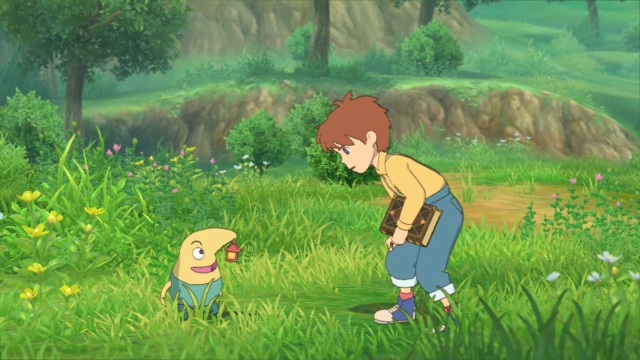
STORY: Although their involvement was limited to lending animation and design talents to proceedings, Studio Ghibli loom large over Ni No Kuni, permeating its universe to the core. Level 5 must have realised what a big deal this game represents, and have crafted an exceptional tale, wearing the influence of their collaborators proudly upon their sleeves. Miyazaki-san would have been more than happy to have penned the story himself, with its familiar theme of a child plucked suddenly from innocence and forced to fend for himself in an unfamiliar world. There are even subtle, fan service type moments within the game, both visually and within the story, that are direct nods to past Ghibli classics. Like Miyazaki’s best works, however, the plot goes far deeper than a simple case of separation anxiety or a played-out take on Alice in Wonderland.
The child in question is Oliver, a bright eyed young man who lives in Motorville, the geographically ambiguous town that is presented like an animé-stylised pastiche of 1950’s Americana. Oliver lives with his doting mother who, in a wonderful early scene, is shown lovingly preparing breakfast for her son, before he gratefully wolfs it down. Ordinarily you would pay no mind to something as trivial as a mother serving up a plate of bacon and eggs, but in context it becomes a perfect, tender vignette of the love a mother has for her child, and is as beautifully observed a moment as you will ever see in gaming. It is a stark contrast to what follows, as in setting up Oliver’s grand adventure, Level 5 hits us with an early thump-to-the-guts tragedy as powerful as anything you will witness in a movie. From the horrendous sight of seeing a child racked by guilt, eaten up by grief and loss, comes the genius touch of introducing the other main character who helps the boy cope with his heartache, the magnificent Lord High Lord of the Fairies, Mr Drippy, who somewhat abruptly (and hilariously) snaps Oliver out of his morose state. Mr Drippy gives the young man renewed hope by revealing how Oliver’s world and his are linked, that certain individuals within each world share a heart and a special bond. Could there be a way to bring back his mother?
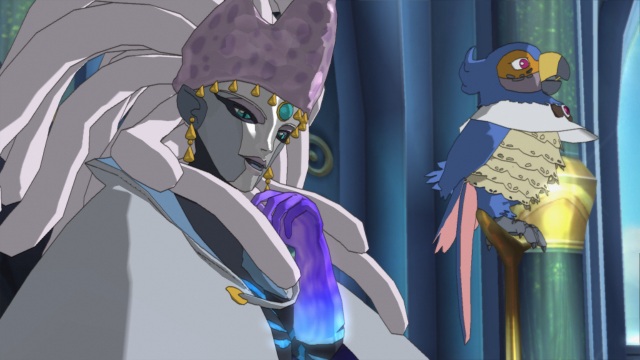
Ni No Kuni is a game about heart, about courage, about the love that a mother has for her child and vice versa. It deals with the stock RPG themes of good versus evil, but does so with so much verve, such incredible attention to detail, and a script so warm, so funny, and so heart rending that at times you actually find yourself looking forward to a break in the action so you can enjoy the next wonderful cut-scene. Oliver’s quest takes him across a wonderfully designed world and introduces a selection of characters as memorable and well-rounded as anything you will see in a video game this year. It has the feel of a classic 16-bit RPG, from the golden era where Squaresoft and Enix were delivering sophisticated, emotionally-affecting storylines in classics like Chrono Trigger, vintage Dragon Quest and Final Fantasy. It is a game that manages to successfully make progress compelling not just from a gameplay, levelling up perspective, but also to find out what will happen to Oliver next.
GRAPHICS: You know that you are dealing with something a bit special when graphically there is barely any difference between what you are seeing during the action segments and what goes down during the story interludes. Level 5 are past masters of employing crisp, colourful cel-shading for maximum effect, and Ni No Kuni is their masterpiece. Between them, Ghibli and the veteran developer have created a gaming world that is breathtaking in its beauty and scope. It is the most sumptuous looking animé-styled treat that you will ever encounter in gaming, a living, breathing, fully interactive movie with settings and characters that would not look out of place on a cinema screen.
Everything about the game looks remarkable. The beautiful 3D in-game sprites are rendered so that they mesh seamlessly with the 2D cel-shaded cut-scenes, losing nothing in translation. Oliver, with his bright scarlet cape and mixture of childlike wonder and stoic defiance, is cut from the same cloth as other iconic children in the Miyazaki pantheon. He becomes the focal point of this incredible story, and is given a truly stunning world to explore. The picket fences and small town charm that opens proceedings gives way to a stunning, fully explorable 3D world map. Imagine the map from a PSOne-era Final Fantasy, only presented in incredible high definition detail, with the benefit of a Studio Ghibli assist. It looks that good.
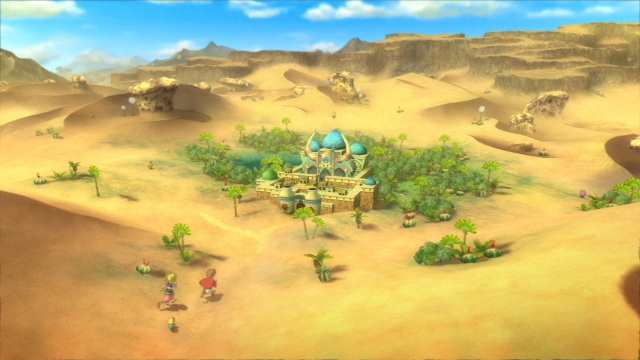
You will visit many different locations – lush, verdant forests, bustling towns, dank underground caverns, desert outposts – and all of them are teeming with activity, be it with the beautifully realised bestiary of Pokémon-esque monsters, or the many races you encounter across the huge magical kingdom. Incredible fantasy vistas, epic landscapes with swirling white-wind vectors, enormous tree canopies reminiscent of Princess Mononoke, gigantic, arcane castles, huge, imaginative bosses; these are all things you get to cast your eyes upon after just a few hours spent with the game. But the little, subtle touches often carry as much gravitas as the grand set pieces; the incredible breakfast scene, the adorably animated familiars, and most of all the brilliant Mr Drippy, who always seems to be up to something amusing in every frame. Leave the game idling and he will dance a silly little pirouette before falling over, or gaze up adorably at his new master with a winning smile on his face. Early on there is a flourish of visual humour during the most unlikely moment, as an emotional scene of family reconciliation takes place, Drippy larks about in the background using a hat as his comedy prop. It made me laugh uncontrollably, and smile for a considerable period afterwards.
SOUND: Given his close ties to Ghibli, it was an obvious choice to bring in legendary composer Joe Hisaishi to score Ni No Kuni. His compositions, performed by the Tokyo Philharmonic Orchestra, are absolutely first class; quite simply one of the finest RPG soundtracks for aeons. While there is an option to retain the original Japanese voice-over work (with subtitles) to accompany the stunning orchestral tunes, the Western actors do a superb job in bringing the characters to life. The last time a major Level 5 RPG was translated for Western audiences, they chose their voice cast incredibly well, using actors with regional accents to give a depth and warmth to proceedings. Former Eastender Ricky Grover’s exceptional Yangus was a slice of Cockney hilarity in Dragon Quest VIII, a brilliant foil to the silent hero of the piece. The voice cast all do a great job, and there are certainly no jarring vocal contributions here.
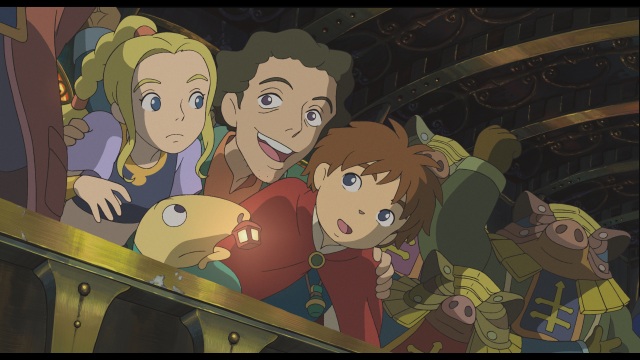
Mr Drippy is the clear star of the show, however, and is voiced in a thick Welsh brogue by actor Steffan Rhodri, best known as Dave “Coaches” from popular UK sitcom Gavin & Stacey. Drippy’s Japanese counterpart is brought to life with a strong Osaka accent, a unique twang often bestowed on comedic (or dare I say “country bumpkin-style”) characters in Japanese games. The Valleys accent was chosen to make Drippy stand out in similar fashion, and it works absolutely perfectly, even stretching to the subtitles, where words like “Your” become “Youer”, and sentences are peppered with gems like “En it” and “mun”. He constantly chatters during the early stages of the game in the role of tutor, explaining the game system, telling you where to go next, cracking jokes and even making fun of his new master. It is a killer turn from Rhodri, who helps make Drippy one of the most memorable and genuinely funny characters ever encountered in gaming.
There are other incredible touches at play that help to immerse you in the game-world, characters in the background can be heard chattering and talking amongst themselves, a merchant will continue to hawk his wares with claps and shouts, a group of children in an early village giggle and frolic as you pass.
GAMEPLAY: Having mind-blowing graphics and a cinematic soundtrack means nothing if the actual gameplay (and indeed the role-playing game mechanics) are not up to scratch. Starting out slowly with a steady trickle of new abilities and party members, the game builds in classic traditional JRPG style. It’s not a dynamic tour-de-force by any means, and it doesn’t reinvent the wheel, but it does make a genre that has fallen into the doldrums feel fresh and vital. Buoyed by the excellent story and triple-A aesthetics, it harks back to a more innocent time in gaming. It borrows little bits from other terrific games, there are certainly elements of Pokémon, even a bit of Zelda in some of the side quests on offer. Whether you were weaned onto turn based RPGs in the early 1990s like me, or prefer how newer role players like Final Fantasy XI and Xenoblade Chronicles mix things up with real-time battle systems, there is something to like here.
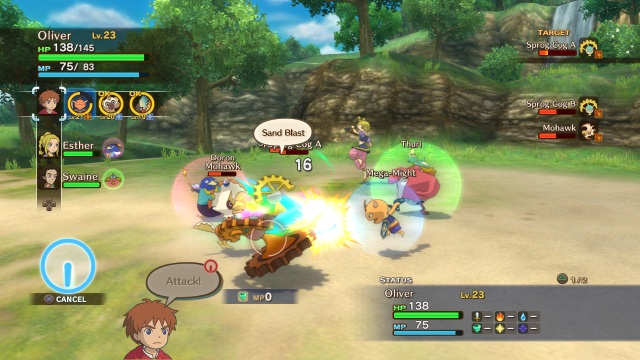
Once you arrive in Mr Drippy’s alternate dimension, gameplay revolves around Oliver traversing the world map to reach his intended destinations, such as the beautifully named Ding Dong Dell, whilst either avoiding or entering into combat with the monsters that roam around the landscape. There are no random battles; enemies are in clear sight. Sometimes an aggressive foe will attack you, whereas weaker creatures may run away. You can initiate combat simply by touching a monster, and in similar fashion to how leaping onto the head of a Goomba in the Paper Mario-verse will give Mario an advantage in the ensuing turn-based melee, successfully surprising a beastie from behind will give you the upper hand when battle commences. The battle screen is in 3D with all encounters taking place in a circular arena. Initially the game gives you the opportunity to attack, defend, or cast a magic spell, and allows you to run around to avoid your opponents should you wish. You move using the analogue stick, and choose your action with the D-Pad. Sometimes, orbs known as Glims appear on the battlefield (or are thrown in by Mr Drippy) which can help replenish your MP and HP, or will allow you to unleash a mega-powerful Ultimate Attack. To begin with, the monsters you come across are fairly tame and can be smashed to oblivion with a few swats of your wand, but it doesn’t take long for the difficulty to ramp up several notches, meaning you will need to make best use of all of the evasive techniques in your arsenal, manage items, and concentrate on dealing out damage at the same time. Some will find the control system awkward, particularly when alternating between D-Pad and analog stick, but it means that battles do become a thrilling balancing act and you will have to use your brain as well as your reflexes to survive and prevail. Use of guard techniques are as important to combat here as they are in a one-on-one fighting game, and can be the difference between life and death, particularly in boss battles.
Battle becomes even more interesting when you are introduced to Familiars, utterly ace little creatures created by the goodness within human hearts, that you can use in battle, level up (by feeding them cakes, which you can see in our battle guide video feature) and train to learn new abilities known as Tricks. There are a plethora of these little fellas to find throughout the game – over 200! – and each of the main members of your party (which itself increases in number as you progress) can take three Familiars with them into combat. Different Familiars get on better with different characters, whilst repeated use of a particular Familiar will build loyalty and create a bond between you and your special little guy. This means that the possibilities for customising your party are practically infinite, so being able to “program” other party members and instruct them how to behave during battle is a Godsend, particularly when you factor that each Familiar can only stay in battle for a limited time before conking out and requiring a cooling off period, and there can be a hell of a lot of juggling when you are in control of three humans, each with three of the blighters to worry about.
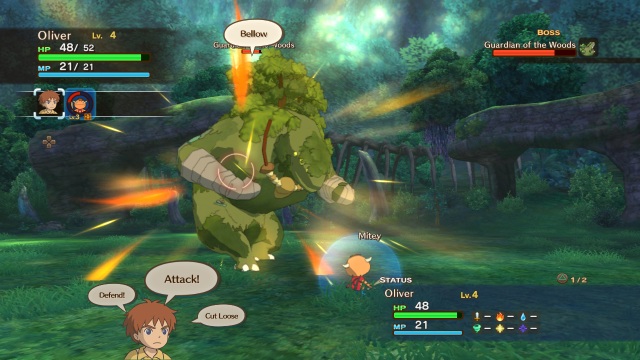
The game is very much story-driven, with an emphasis on exploration, solving puzzles and conquering dungeons, yet the story is interwoven with such emotion and feeling that it transcends the usual run of the mill role playing experience. Many of the tasks Oliver finds himself carrying out are mercy missions, using his new found magical abilities to heal the broken hearts of folk who have had their emotions torn asunder by the villain of the piece, leaving them a shadow of their former selves. The way that these individuals are affected is profoundly moving at times and entirely realistic, an early example being a normally good natured dad who has lost his kindness, and responds by ostracising his daughter and committing what is tantamount to spousal abuse upon his loving wife. This may seem like a world of whimsy and wonder, but the denizens of Ni No Kuni have problems rooted in real life that any gamer will be able to identify with. It is stirring stuff, going out there in the world and doing some good with your pal Mr Drippy by your side.
LONGEVITY: There is a lengthy quest at the core of this game that will take an easy fifty hours of your time, no question. However, like any classic role playing experience there are a myriad of other ways to pass your time and rack up many more glorious hours of adventuring. Seeking out new pages for Oliver’s sumptuous book of spells, which can be leafed through in the perfectly designed menu screens, is a compulsive treat. There are a hundred hidden treasure chests, secret Familiars to discover, a Pokémon-style Familiar battle arena, monster bounty hunting quests, a fully operational casino, the usual shedload of weapons, items and armour types to play around with, and much more. The world map in itself is a veritable treasure trove of hidden villages, items, pathways, islands and monsters. Later on you get to access alternative modes of transport which makes the map even more fun. The game makes you want to explore, to deviate from the path a little, to eschew the linear elements of the plot to get your hands on the next juicy hidden secret.

VERDICT: Ni No Kuni is a superb traditionally-styled role player, that is carried along by a magnificent story that is the equal of the very best family films, those of Studio Ghibli included. It spirits you away, so to speak, into its stunning fantasy world in those breathtaking early scenes, and does not let go. It is a game full of heart, of magical and unbridled wonder, that has lost nothing in the localisation process, something that Namco Bandai need to be applauded for allowing to happen.
It has been a long time since I have played a game of this type and been bowled over in such dramatic fashion. The desire to play more, to spend some more time in this other world with my new pal Mr Drippy, was almost overwhelming each time I put the control pad down. It is a game that people will get a thrill out of simply watching in motion, and has a wonderfully universal story that touches the basic emotions within us all. This is a title that is sure to be amongst the discussions when the best games of 2013 are pondered. It may just be my favourite ever role-playing game, and is unquestionably the best looking; one of the graphical high points for the PlayStation 3.







